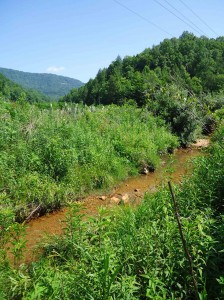 Despite cool, rainy weather in Frankfort, KY, more than 1,200 individuals showed up on the steps of the Kentucky state capitol building for I Love Mountains Day. This annual event is held by Kentuckians for the Commonwealth so that KFTC members and other advocates can come together to show their support for protecting eastern Kentucky’s mountains and communities. Eric Chance and I were lucky to be part of a great event with a diverse and enthusiastic crowd.
Despite cool, rainy weather in Frankfort, KY, more than 1,200 individuals showed up on the steps of the Kentucky state capitol building for I Love Mountains Day. This annual event is held by Kentuckians for the Commonwealth so that KFTC members and other advocates can come together to show their support for protecting eastern Kentucky’s mountains and communities. Eric Chance and I were lucky to be part of a great event with a diverse and enthusiastic crowd.
We were initially met with the sight of several pro-coal billboard trucks circling the capitol building, but they did not appear to stay throughout the entire rally. The mood was immediately lifted upon reaching the steps of the capitol, where 2/3 Goat, a New York band that has become a regular part of many similar gatherings, began to play.
Speakers included Steve Boyce, Ada Smith, Teri Blanton, Melina Laboucan-Massimo, Cody Montgomery, Randy Wilson and Stanley Sturgill. Each spoke to his or her own experience with mountaintop removal and other forms of destructive energy extraction. Senator Kathy Stein also made a brief appearance to voice her support for our continued work and the progress she believes we are making. Speakers voiced their support for their fellow community members who work as miners, but stressed that after over 100 years of providing coal for the state and the country, Kentucky needs to diversify its economy and energy resources. It is time to show the people of eastern Kentucky the respect they deserve, by providing for healthy communities, a healthy environment, energy efficiency, and economic opportunity.

Melina Laboucan-Massimo, from Alberta, Canada, spoke about the impact of tarsands oil extraction on her local community. The problems, including poisoned water and high occurrences of rare cancers, were eerily similar to the problems seen in coal-impacted communities throughout Appalachia. As more studies have been completed, it is clear that these health problems are not just anecdotal, but are verifiable trends that reflect the injustices done to people living near mountaintop removal sites.
Despite the harsh realities many in eastern Kentucky still face, all of the speakers were upbeat and extremely motivating. The crowd seemed equally hopeful. The rally concluded with a march to Governor Beshear’s mansion, where 1,200 pinwheels were left, each on symbolizing 50 people living with cancer caused by strip mining in their community (Source: Journal of Community Health, July 2011). Eric and I left the rally with new motivation for the work we will do this week in Kentucky, as well as the hopefully not-so-long road ahead.
For more information and photographs, check out KFTC’s coverage of the event or click here to see more of our pictures.

Faces of Coal Hates Mountains
 I checked Facebook early on the morning of January 9th, cursing my mild addiction to social media, and was suddenly glad that I had. I saw a news report of a chemical spill in Charleston, W.Va., which I quickly emailed to the rest of the staff at Appalachian Voices. I then packed a bag anticipating the potential to be gone for several days. I knew as little about what I might be doing through my work with Appalachian Water Watch as I did about what exactly had happened in Charleston. [ Read More ]
I checked Facebook early on the morning of January 9th, cursing my mild addiction to social media, and was suddenly glad that I had. I saw a news report of a chemical spill in Charleston, W.Va., which I quickly emailed to the rest of the staff at Appalachian Voices. I then packed a bag anticipating the potential to be gone for several days. I knew as little about what I might be doing through my work with Appalachian Water Watch as I did about what exactly had happened in Charleston. [ Read More ]












